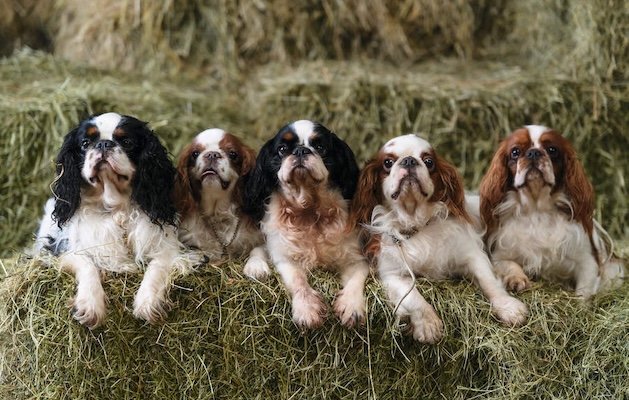David Tomlinson finds the Cavalier King Charles Spaniel delightfully active – although it was bred to be a lapdog.
A while back I interviewed a gundog breeder and trainer with a passion for Cavalier King Charles Spaniels. He assured me that the cavalier was the perfect gamebag gundog. You could pop it in your bag on a shooting day and get it out when it was needed, such as when looking for the runner that all the labradors had failed to find. (Read what is the best colour for a labrador?)
A couple of decades later, I’m coming round to the idea of gamebag gundogs in general and cavaliers in particular. The latter may be toy spaniels, bred originally to be foot warmers and lapdogs in Tudor England, but they’ve never quite forgotten their spaniel ancestry and many still display an unlikely enthusiasm for hunting. One breed profile I found insists that the cavalier “retains the sporty nature of his spaniel ancestors. If he’s not sitting on a lap or getting a belly rub, nothing makes him happier than to flush a bird and then attempt to retrieve it.”
The origin of Cavalier King Charles Spaniels?
The first Duke of Marlborough, John Churchill, kept diminutive, red-and-white spaniels for shooting and they were described at the time as “excellent and indefatigable, being in great estimation with those sportsmen who can become possessed of the breed”. These became known as Blenheim spaniels, and today one of the four recognised cavalier colours is the chestnut-and-white Blenheim.
If you search the spaniel literature, references to both Blenheims and cavaliers are frequent. In Claude Cane’s The Sporting Spaniel, published originally in 1906, the author recalls enjoying excellent sport “some quarter of a century ago over a team of King Charles spaniels in the south of Ireland. There were acres of wild gorse in the park, inhabited by countless rabbits, and these little animals which one is accustomed only to think of in connection with a lady’s lap, used to face the dense and prickly covert with a determination and keenness which would have done credit to any of their larger cousins.”
In the field
I’ve never seen a cavalier in the shooting field but I have had plenty of experience of the breed as several cavaliers belonging to friends have enjoyed holidays at Maison Tomlinson. One, fittingly a Blenheim, even accompanied me to a Game Fair at Blenheim. Here, strangers came up, made a fuss of her and declared that they used to have a cavalier just like her. Chloe, another holidaying cavalier and not the most energetic of dogs, astonished me once by pursuing my chickens with what seemed like deadly intent. There’s more to a cavalier than meets the eye.
Peter Moxon, for 40 years kennel editor of Shooting Times, recommended the Cavalier King Charles as the ideal canine companion for the sportsman, or woman, who had had to give up their springers or labradors but still wanted a proper dog. Intelligent and easy to train, cavaliers are renowned for being affectionate and friendly. Whether Moxon would suggest a cavalier today is another matter as, sadly, modern cavaliers suffer from a host of hereditary diseases caused largely by commercial breeding from unhealthy stock. One of the most serious complaints is syringomyelia, a condition that affects the brain and spine and is caused by a mismatch between the size of the brain and the shape of the skull. Other problems include keratoconjunctivitis sicca (dry eye), explained partially by the protuberant eyes favoured by some breeders. Hip dysplasia is not uncommon and nor is episodic falling syndrome, an epileptic-like condition. Most worrying of all is mitral valve disease, which starts with a heart murmur and often ends in heart failure.
So if you are planning to buy a cavalier, do so with care from a breeder whose stock has been health tested. The Cavalier King Charles Spaniel Club takes health seriously and has a register of puppies for sale from responsible breeders. There’s no guarantee that a puppy will be healthy even if bred from health-tested stock, but it’s a good start.
Of course, there’s no reason to buy a pedigree puppy and with the current vogue for designer crossbreds there are plenty of other options. Cavapoos – a cavalier crossed with a poodle – are remarkably popular, but whether they have any sporting prowess is another matter. A rather more interesting cross would be a cavalier crossed with a working cocker – that could really be a pocket rocket. I’ve yet to meet one, and I’m not sure what you would call such a hybrid. Perhaps a cockalier? (Read more about cockapoos in the shooting line here.
This article was originally published in 2019 and has been updated.





